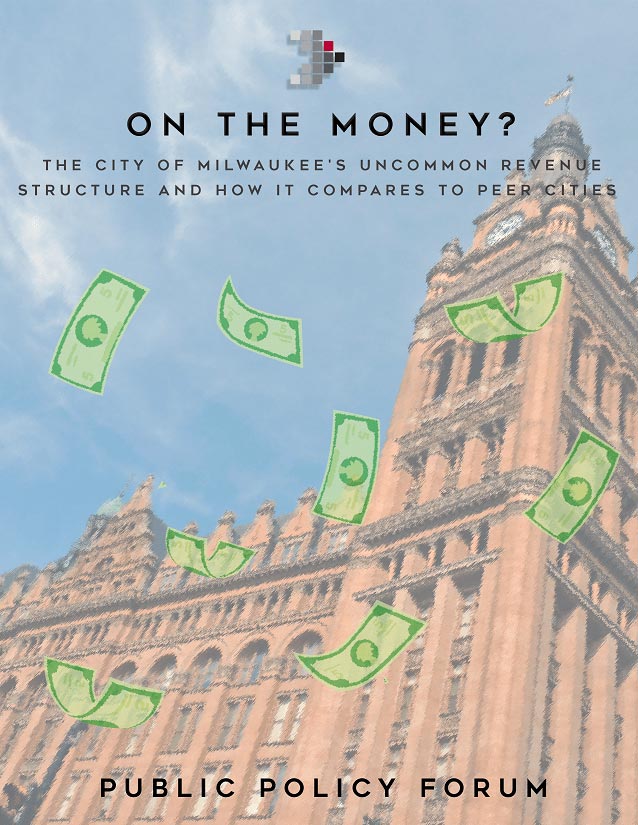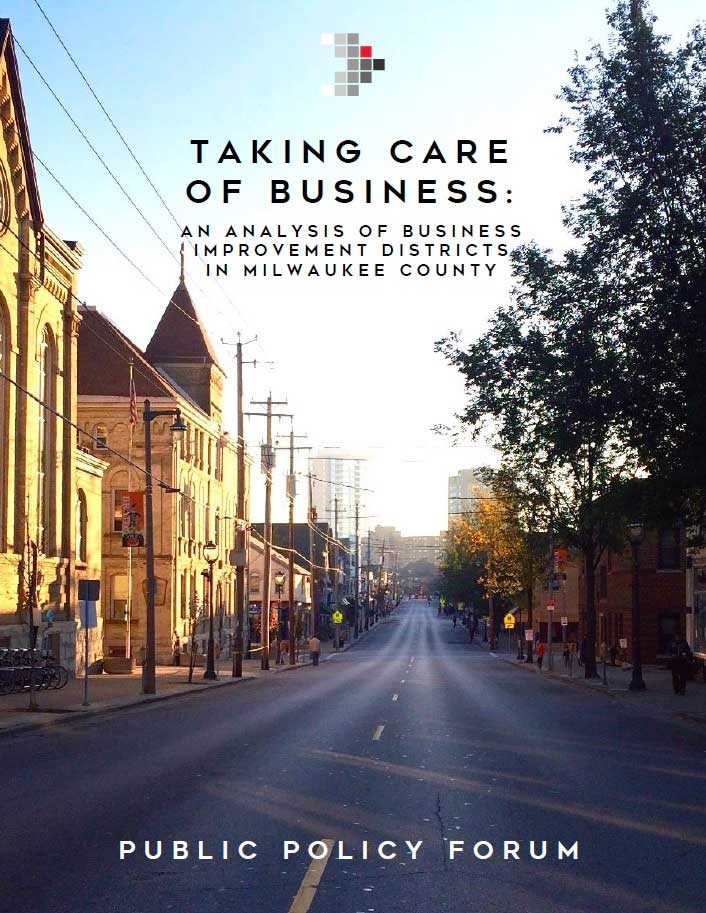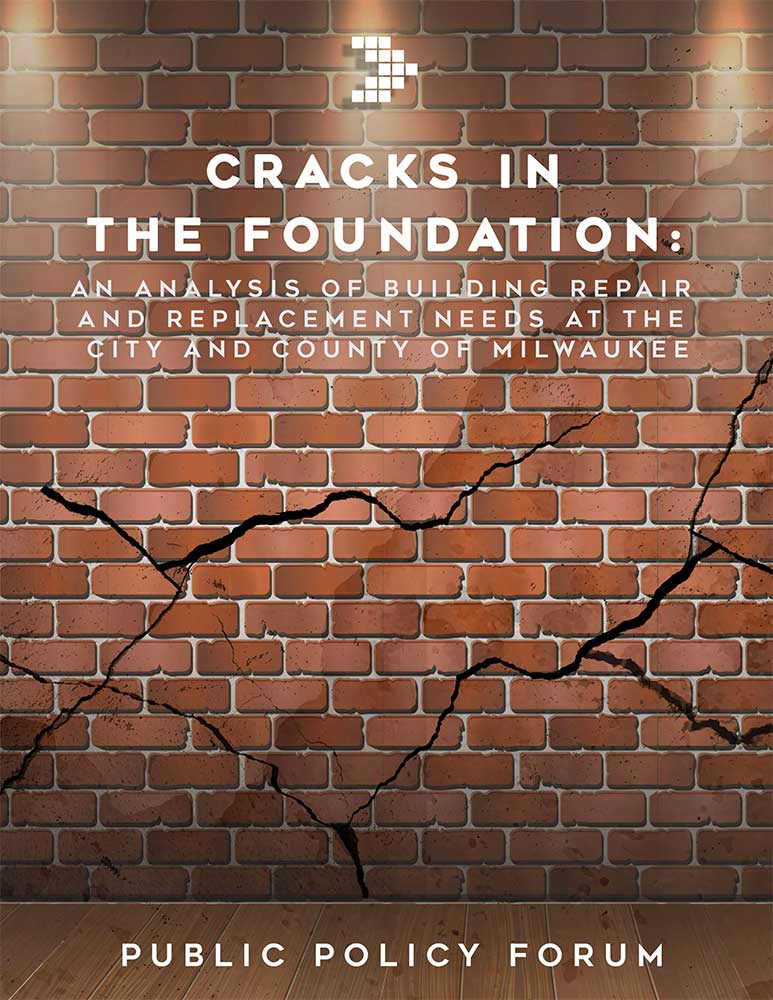



It’s been a busy year for the Forum. Despite all of the work involved with our merger with WISTAX, our research agenda has remained robust and our research findings have been the subject of policy deliberations on many fronts. Here, we take one more look back to unveil the Forum’s top five research findings of 2017.
Last year’s list included findings on Milwaukee marijuana arrests, the region’s teacher pipeline, City of Milwaukee targeted hiring efforts, Milwaukee County bus replacement needs, and Milwaukee police spending. This year’s list touches on one of those topics, as well as issues related to transit, economic development, infrastructure, and City of Milwaukee finances. Here’s the 2017 list in chronological order:
 Last mile transit strategies are being used in other regions to boost the overall popularity of transit. In March, we released The Last Mile, a report that explored strategies the Milwaukee County Transit System might use to effectively connect commuters to their job sites when their bus routes stop just short. We found that strategies used in other metro regions not only are designed to accomplish that goal, but also can result in technological upgrades and relationships with ride sharing entities (e.g. Uber and Lyft) that appeal to broader populations of transit users. In other words, pursuit of last mile strategies — like flexible or on-demand transit — also might help MCTS become more attractive to younger generations.
Last mile transit strategies are being used in other regions to boost the overall popularity of transit. In March, we released The Last Mile, a report that explored strategies the Milwaukee County Transit System might use to effectively connect commuters to their job sites when their bus routes stop just short. We found that strategies used in other metro regions not only are designed to accomplish that goal, but also can result in technological upgrades and relationships with ride sharing entities (e.g. Uber and Lyft) that appeal to broader populations of transit users. In other words, pursuit of last mile strategies — like flexible or on-demand transit — also might help MCTS become more attractive to younger generations. Milwaukee’s exclusive reliance on the property tax makes it unique. On the Money?, released in July, compared Milwaukee’s revenue structure with 38 other U.S. cities with populations between 300,000 and one million. We found, remarkably, that Milwaukee is the only one required by its state government to rely on the property tax as its sole major form of local taxation. In fact, 30 have a general sales tax and each of the remaining eight generates substantial revenue from selective sales taxes. We also found that as a general rule, cities with larger populations tend to draw more heavily on the sales tax and less upon the property tax, as sales taxes help them recoup the costs of services from workday commuters, tourists, entertainment patrons, etc.
Milwaukee’s exclusive reliance on the property tax makes it unique. On the Money?, released in July, compared Milwaukee’s revenue structure with 38 other U.S. cities with populations between 300,000 and one million. We found, remarkably, that Milwaukee is the only one required by its state government to rely on the property tax as its sole major form of local taxation. In fact, 30 have a general sales tax and each of the remaining eight generates substantial revenue from selective sales taxes. We also found that as a general rule, cities with larger populations tend to draw more heavily on the sales tax and less upon the property tax, as sales taxes help them recoup the costs of services from workday commuters, tourists, entertainment patrons, etc. Milwaukee has more business and neighborhood improvement districts (BIDs and NIDs) per capita than any city in the U.S. Taking Care of Business, our August report that explored the use of BIDs and NIDs to enhance economic development in Milwaukee County, found that the City of Milwaukee has 32 BIDs and 7 NIDs. On a per capita basis, that’s more than twice as many as the second-place city (Minneapolis). We also found that in terms of absolute numbers, Milwaukee ranks third, trailing only the much larger cities of New York and Chicago. A lack of performance data precluded us from determining whether our unusually high preponderance of BIDs and NIDs is having a positive impact, but we hope to revisit that question in the near future.
Milwaukee has more business and neighborhood improvement districts (BIDs and NIDs) per capita than any city in the U.S. Taking Care of Business, our August report that explored the use of BIDs and NIDs to enhance economic development in Milwaukee County, found that the City of Milwaukee has 32 BIDs and 7 NIDs. On a per capita basis, that’s more than twice as many as the second-place city (Minneapolis). We also found that in terms of absolute numbers, Milwaukee ranks third, trailing only the much larger cities of New York and Chicago. A lack of performance data precluded us from determining whether our unusually high preponderance of BIDs and NIDs is having a positive impact, but we hope to revisit that question in the near future. Milwaukee County’s building repair and improvement needs currently appear unmanageable. In September, we released Cracks in the Foundation, the third in our five-part series of reports on local government infrastructure. We found that given the projected need to spend more than $200 million on a new Safety Building and other long-deferred projects, Milwaukee County lacks the capacity to finance the capital needs of its buildings if it wishes to stay within its self-imposed borrowing limits. In fact, even if the need to replace the Safety Building did not exist, we found that the County should more than double its spending on building-related projects in 2018 (from $12 million to $24 million) and almost quadruple it to $45 million in 2019.
Milwaukee County’s building repair and improvement needs currently appear unmanageable. In September, we released Cracks in the Foundation, the third in our five-part series of reports on local government infrastructure. We found that given the projected need to spend more than $200 million on a new Safety Building and other long-deferred projects, Milwaukee County lacks the capacity to finance the capital needs of its buildings if it wishes to stay within its self-imposed borrowing limits. In fact, even if the need to replace the Safety Building did not exist, we found that the County should more than double its spending on building-related projects in 2018 (from $12 million to $24 million) and almost quadruple it to $45 million in 2019. Teacher turnover has stabilized in recent years in metro Milwaukee and across Wisconsin, but the newest teachers are leaving at higher rates. Stay in School, our December report revisiting trends in the teacher workforce, found that after an exodus of teachers immediately following the adoption of Wisconsin Act 10, teacher attrition levels in metro Milwaukee and the state have returned to pre-Act 10 levels. In fact, the region’s teacher workforce had 75 more teachers in the 2015-16 school year than it did when we last examined the data two years ago, and the state had 140 more teachers. Less promising was our finding that there has been a shift toward higher proportions of younger and less experienced teachers leaving the workforce in both the state and metro Milwaukee.
Teacher turnover has stabilized in recent years in metro Milwaukee and across Wisconsin, but the newest teachers are leaving at higher rates. Stay in School, our December report revisiting trends in the teacher workforce, found that after an exodus of teachers immediately following the adoption of Wisconsin Act 10, teacher attrition levels in metro Milwaukee and the state have returned to pre-Act 10 levels. In fact, the region’s teacher workforce had 75 more teachers in the 2015-16 school year than it did when we last examined the data two years ago, and the state had 140 more teachers. Less promising was our finding that there has been a shift toward higher proportions of younger and less experienced teachers leaving the workforce in both the state and metro Milwaukee.Given our release of 18 research reports in 2017, it was challenging to narrow our list of top findings to five. Left off the list this year were important findings related to the capital needs of the Milwaukee Water Works; metro Milwaukee’s progress in moving to a knowledge-based economy; the potential for consolidated health services in Oak Creek and South Milwaukee; the characteristics of students enrolling in Career & Technical Education classes in area high schools; the amounts of public dollars being devoted to youth development in Milwaukee; and the potential for efficiencies through service sharing between MPS, the City, and the County. Those interested in reviewing these and other research findings can access the Forum’s full list of research publications here.